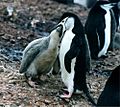Trophallaxis facts for kids

Trophallaxis is a special way animals share food or other liquids with each other. It's like passing a snack around to your friends! This behavior is most common in social insects, such as ants, termites, wasps, and bees, where many individuals live and work together in a colony.
The word "trophallaxis" was first used by a scientist named William Morton Wheeler in 1918. Another scientist, August Forel, also thought that sharing food was super important for how ant societies work. He even put a picture of ants sharing food at the front of his book about ant life!
Contents
Why is Trophallaxis Important?
Trophallaxis is more than just sharing food; it's also a way for animals to communicate with each other.
- Sharing Food: The most obvious reason is to make sure everyone in the colony gets enough to eat, especially the young ones or the queen.
- Communication: In bees and ants, trophallaxis helps them share information. For example, a bee might share nectar with other bees, which also tells them where to find good flowers.
- Colony Identity: For some ants, sharing food helps spread the unique smell of their colony. This smell acts like a secret handshake, letting them know who belongs to their group and who doesn't. It helps them recognize their family members and keep strangers out.
Who Uses Trophallaxis?
While it's most famous in insects, other animals also show similar food-sharing behaviors.
Social Insects
- Ants: Ants are masters of trophallaxis. They often store food in a special stomach called a "crop" and then bring it back to the nest to share with other ants, including the queen and the young larvae.
- Bees: Honey bees use trophallaxis to share nectar and pollen. This helps spread nutrients throughout the hive and also helps them communicate about food sources.
- Termites: Termites also share food and other important substances, which helps keep their complex colonies healthy.
Other Animals
While not always called trophallaxis, similar food-sharing behaviors can be seen in other animals:
- Birds: Many parent birds feed their chicks by bringing food back to the nest and putting it directly into their mouths.
- Mammals: Some mammals, like wolves or meerkats, might regurgitate (bring up) food they've eaten to share with their young or other members of their pack.
Images for kids
See also
 In Spanish: Trofalaxis para niños
In Spanish: Trofalaxis para niños



